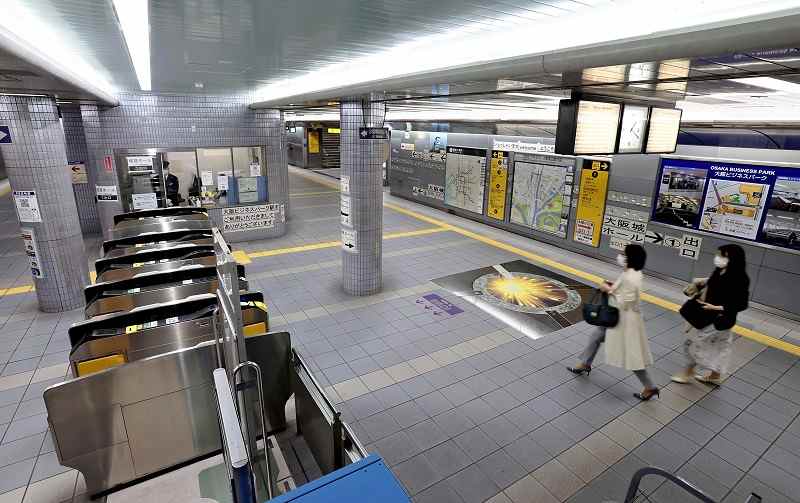
People walk in Osaka Metro’s Osaka Business Park Station on April 19 in Osaka. During an emergency, the area outside the ticket gates can be used as an evacuation site.
5:51 JST, April 25, 2022
There is a growing movement in Japan to designate underground train stations as evacuation facilities after Russia’s invasion of Ukraine, where residents are sheltering in such stations.
Prefectural and municipal governments have begun taking measures with an armed attack by a foreign country in mind.
No underground train stations were designated as evacuation facilities by local governments until March last year, but now there are more than 300. Despite Tokyo having a well-developed subway network, the capital has no stations designated as shelters.
Out of the 133 Osaka Metro underground train stations, 108 have been designated as evacuation facilities, the Osaka prefectural, Osaka city and Sakai city governments announced April 7.
“They cannot stop nuclear weapons, of course, but having [such facilities] increases the chances of saving lives from the destructive power of certain missiles,” Osaka Mayor Ichiro Matsui said at a press conference that day, emphasizing the helpfulness of being able to escape to underground train stations.
Local governments do not designate the areas inside ticket gates as shelters, to prevent evacuees from falling onto train tracks, and regard the underground spaces as “temporary evacuation facilities” in an emergency with expectations that people will move to another site in an hour or two.
“We would like to proceed with negotiations to designate other underground train stations,” said an Osaka city government official.
In preparation for an emergency such as a missile strike, governors and mayors of ordinance-designated cities are required to classify certain places as evacuation facilities, according to the Civil Protection Law which went into effect in 2004. Such facilities include sturdy buildings, underground malls and subway stations.
Of about 94,000 facilities designated as of April 2020, there were 1,127 underground facilities, but no underground train stations classified as such.
In response, the central government in December 2020 requested local governments to promote designating subway stations and underground malls as evacuation facilities.
Designation has progressed since April 2021, and 304 train stations in Sendai, Nagoya and other places have been classified as such as of April 1.
However, there are no such facilities in Tokyo despite the city having an extensive subway network.
At the request of the central government, the Tokyo metropolitan government is considering designating about 100 stations in the Tokyo-run Toei Subway network. However, designations have not progressed because the number of evacuees is expected to be too large to be handled by station staff alone. Treating the injured and providing food to so many people would be difficult in a prolonged evacuation.
“We understand that underground train stations are useful as evacuation sites,” said a Tokyo metropolitan government official. “We’d like to continue considering designations while consulting with cities that have made [such designations].”
Officials also plan to negotiate with private train operators such as Tokyo Metro.
Not deep enough?
However, some experts believe most underground train stations in Japan are not deep enough to significantly mitigate damage.
Arsenalna Station in Kyiv, the Ukrainian capital, is located about 105 meters underground and is one of the deepest subway stations in the world. It is said that the station was designed to function as a nuclear shelter.
On the other hand, Osaka Business Park Station, which is the deepest in the Osaka Metro network, is about 32 meters underground. The deepest station in the Toei Subway network in Tokyo is Roppongi Station on the Oedo Line at about 42 meters underground.
“Even if you were to evacuate to an underground train station in Japan, there is the risk of considerable damage being done by a missile with high destructive power,” said Naofumi Miyasaka, a professor at the National Defense Academy.
However, Miyasaka, an expert of governmental national protection, noted that using underground facilities as evacuation sites is effective since Japan is an island country and there is little room to escape far away.
“Local governments need to make efforts to obtain the cooperation of train operators and proceed with maintenance such as strengthening the shutters at the entrances to the underground spaces,” he said.
"Society" POPULAR ARTICLE
-

M4.9 Earthquake Hits Tokyo, Neighboring Prefectures
-

M7.5 Earthquake Hits Northern Japan; Tsunami Waves Observed in Hokkaido, Aomori and Iwate Prefectures
-

Tsukiji Market Urges Tourists to Avoid Visiting in Year-End
-

Israeli Tourists Refused Accommodation at Hotel in Japan’s Nagano Pref., Prompting Protest by Israeli Embassy and Probe by Prefecture
-

M5.7 Earthquake Hits Japan’s Kumamoto Pref., Measuring Upper 5 Intensity, No Tsunami Expected
JN ACCESS RANKING
-

Keidanren Chairman Yoshinobu Tsutsui Visits Kashiwazaki-Kariwa Nuclear Power Plant; Inspects New Emergency Safety System
-

Imports of Rare Earths from China Facing Delays, May Be Caused by Deterioration of Japan-China Relations
-

University of Tokyo Professor Discusses Japanese Economic Security in Interview Ahead of Forum
-

Japan Pulls out of Vietnam Nuclear Project, Complicating Hanoi’s Power Plans
-

Govt Aims to Expand NISA Program Lineup, Abolish Age Restriction






















